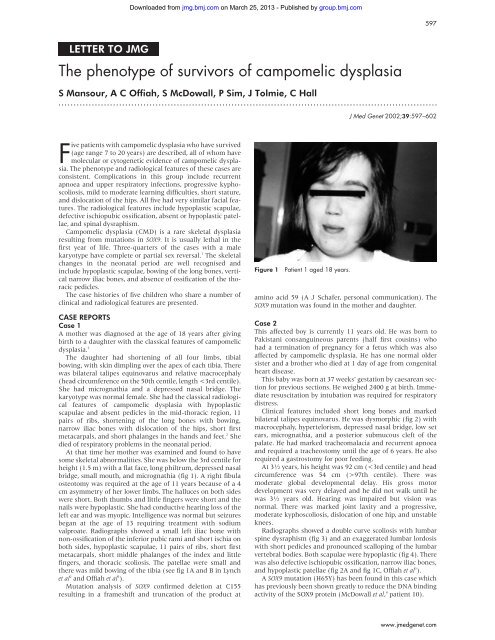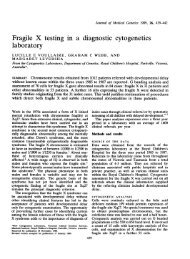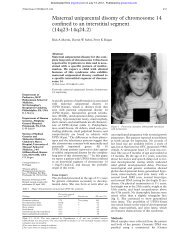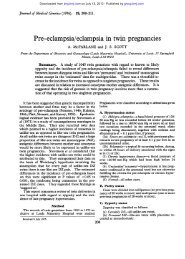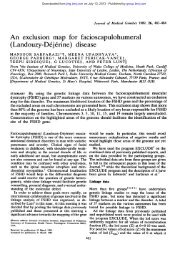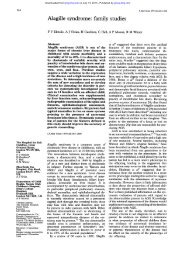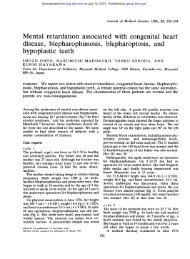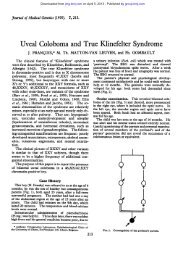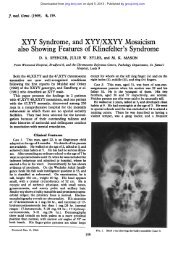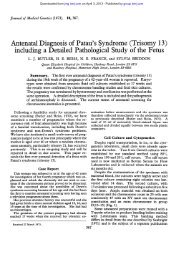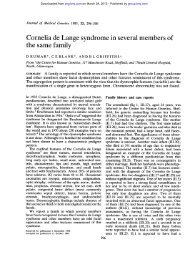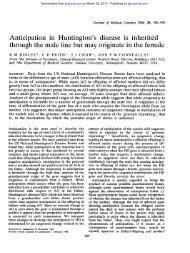The phenotype of survivors of campomelic dysplasia - Journal of ...
The phenotype of survivors of campomelic dysplasia - Journal of ...
The phenotype of survivors of campomelic dysplasia - Journal of ...
Create successful ePaper yourself
Turn your PDF publications into a flip-book with our unique Google optimized e-Paper software.
LETTER TO JMG<br />
<strong>The</strong> <strong>phenotype</strong> <strong>of</strong> <strong>survivors</strong> <strong>of</strong> <strong>campomelic</strong> <strong>dysplasia</strong><br />
S Mansour, A C Offiah, S McDowall, P Sim, J Tolmie, C Hall<br />
.............................................................................................................................<br />
F ive<br />
Downloaded from<br />
jmg.bmj.com on March 25, 2013 - Published by group.bmj.com<br />
patients with <strong>campomelic</strong> <strong>dysplasia</strong> who have survived<br />
(age range 7 to 20 years) are described, all <strong>of</strong> whom have<br />
molecular or cytogenetic evidence <strong>of</strong> <strong>campomelic</strong> dyspla-<br />
sia. <strong>The</strong> <strong>phenotype</strong> and radiological features <strong>of</strong> these cases are<br />
consistent. Complications in this group include recurrent<br />
apnoea and upper respiratory infections, progressive kyphoscoliosis,<br />
mild to moderate learning difficulties, short stature,<br />
and dislocation <strong>of</strong> the hips. All five had very similar facial features.<br />
<strong>The</strong> radiological features include hypoplastic scapulae,<br />
defective ischiopubic ossification, absent or hypoplastic patellae,<br />
and spinal dysraphism.<br />
Campomelic <strong>dysplasia</strong> (CMD) is a rare skeletal <strong>dysplasia</strong><br />
resulting from mutations in SOX9. It is usually lethal in the<br />
first year <strong>of</strong> life. Three-quarters <strong>of</strong> the cases with a male<br />
karyotype have complete or partial sex reversal. 1 <strong>The</strong> skeletal<br />
changes in the neonatal period are well recognised and<br />
include hypoplastic scapulae, bowing <strong>of</strong> the long bones, vertical<br />
narrow iliac bones, and absence <strong>of</strong> ossification <strong>of</strong> the thoracic<br />
pedicles.<br />
<strong>The</strong> case histories <strong>of</strong> five children who share a number <strong>of</strong><br />
clinical and radiological features are presented.<br />
CASE REPORTS<br />
Case 1<br />
A mother was diagnosed at the age <strong>of</strong> 18 years after giving<br />
birth to a daughter with the classical features <strong>of</strong> <strong>campomelic</strong><br />
<strong>dysplasia</strong>. 2<br />
<strong>The</strong> daughter had shortening <strong>of</strong> all four limbs, tibial<br />
bowing, with skin dimpling over the apex <strong>of</strong> each tibia. <strong>The</strong>re<br />
was bilateral talipes equinovarus and relative macrocephaly<br />
(head circumference on the 50th centile, length
598 Letter<br />
Figure 2 Patient 2 aged 3.5 years.<br />
Figure 3 Case 2: AP thoracolumbar spine (aged 9 years) showing<br />
double curve scoliosis and lumbar spinal dysraphism.<br />
Case 3<br />
This child is now 7 years old but was reviewed at the age <strong>of</strong> 1<br />
year. She was born at 42+ weeks by normal vaginal delivery to<br />
unrelated parents who had a previous normal child. <strong>The</strong> pregnancy<br />
had been uneventful apart from hyperemesis and antenatal<br />
scans were reported as normal at 19 and 41 weeks. At<br />
birth, intubation and ventilation were required immediately<br />
but she was successfully extubated after 24 hours. She<br />
required a nasopharyngeal tube for five weeks and there was<br />
marked hypotonia.<br />
She had a variable degree <strong>of</strong> stridor and recurrent apnoea<br />
usually associated with feeding. <strong>The</strong>re was a progressive<br />
www.jmedgenet.com<br />
Downloaded from<br />
jmg.bmj.com on March 25, 2013 - Published by group.bmj.com<br />
Figure 4 Case 2: AP chest (aged 7.5 years) showing hypoplastic<br />
scapulae with absent scapular wings and lateral clavicular hooks.<br />
kyphoscoliosis from the age <strong>of</strong> 3 months requiring spinal<br />
fusion and brace. Her hips were not dislocated but she had<br />
dislocatable knees. <strong>The</strong>re was mild conductive hearing loss but<br />
vision at one year was normal. <strong>The</strong>re was mild global developmental<br />
delay but gross motor skills were more markedly<br />
delayed. On examination, she was short with a height <strong>of</strong> 68 cm<br />
(
Figure 5 Case 3: lateral tibia and fibula (aged 1 year) showing<br />
disproportionately short fibula, hypoplastic distal tibial epiphysis,<br />
and anterior bowing <strong>of</strong> the tibia.<br />
Figure 6 Patient 4.<br />
Downloaded from<br />
jmg.bmj.com on March 25, 2013 - Published by group.bmj.com<br />
Letter 599<br />
Case 5<br />
This woman is now 21 years old (she has four normal sibs).<br />
Birth was at term by emergency caesarean section for fetal<br />
distress. She had respiratory distress in the neonatal period<br />
but was not ventilated. At birth, she was noted to be short<br />
limbed and had bilateral pretibial dimples. <strong>The</strong>re was bilateral<br />
talipes equinovarus which was more severe on the right.<br />
She was dysmorphic with a depressed nasal bridge, hypertelorism,<br />
micrognathia, and low set ears (fig 9). <strong>The</strong>re was a<br />
high arched palate but no cleft palate. On examination, her<br />
height was 119 cm (
600 Letter<br />
Figure 9 Patient 5 aged 21 years.<br />
<strong>The</strong> dysmorphic features <strong>of</strong> all five cases are consistent and<br />
distinctive (table 1). Characteristically there is relative macrocephaly,<br />
depressed nasal bridge, hypertelorism, long philtrum,<br />
micrognathia with or without a cleft palate, and hypotonia.<br />
<strong>The</strong> main clinical problems in the neonatal period are respiratory.<br />
<strong>The</strong>se include recurrent apnoea, chest infections, and<br />
stridor, sometimes requiring tracheostomy. Later complications<br />
include conductive hearing loss, developmental delay,<br />
(especially gross motor), and dental caries with irregular<br />
teeth. Myopia was present in the two oldest patients (cases 1<br />
and 5) and may be a complication in later life.<br />
Other complications have been reviewed in orthopaedic<br />
publications. 5–7 <strong>The</strong>se reports emphasise the presence <strong>of</strong> a<br />
severe and progressive kyphoscoliosis associated with increased<br />
morbidity. Other orthopaedic problems include talipes<br />
equinovarus, congenital subluxation or dislocation <strong>of</strong> the hips,<br />
and dislocation <strong>of</strong> the radial heads causing limitation in supination.<br />
<strong>The</strong>re is a striking change in the disproportion <strong>of</strong> the short<br />
stature with age. At birth there are short limbs with normal<br />
length <strong>of</strong> the trunk, but with the progression <strong>of</strong> the kyphoscoliosis<br />
the trunk becomes relatively shorter than the limbs (fig<br />
9).<br />
Sex reversal was only present in one <strong>of</strong> these cases (case 3)<br />
and was associated with a paracentric inversion <strong>of</strong> the long<br />
arm <strong>of</strong> chromosome 17. <strong>The</strong> other male in this series was not<br />
sex reversed (case 2). In a previously reported series, 73% <strong>of</strong><br />
patients with a male karyotype had female or ambiguous<br />
genitalia. Only four patients had a male karyotype with<br />
normal male genitalia. One <strong>of</strong> these cases is described here,<br />
another survived for four months, and two were terminated in<br />
www.jmedgenet.com<br />
Downloaded from<br />
jmg.bmj.com on March 25, 2013 - Published by group.bmj.com<br />
Figure 10 Case 5: AP left tibia<br />
and fibula (aged 2 years)<br />
showing a short fibula, bowing<br />
<strong>of</strong> the tibia and fibula, small<br />
distal femoral and proximal tibial<br />
epiphyses, and delayed<br />
ossification <strong>of</strong> the distal tibial and<br />
fibular epiphyses.<br />
pregnancy because <strong>of</strong> a prenatal diagnosis <strong>of</strong> a lethal skeletal<br />
<strong>dysplasia</strong>. From these small numbers it is impossible to postulate<br />
that sex reversal is associated with a more severe <strong>phenotype</strong>.<br />
<strong>The</strong>re are two possible explanations for the survival <strong>of</strong> these<br />
patients with CMD. <strong>The</strong> first explanation is mosaicism <strong>of</strong> the<br />
SOX9 mutation. This is the most likely reason for survival in<br />
case 1. This woman had clinical and radiological evidence <strong>of</strong><br />
asymmetry and gave birth to a girl with classical lethal CMD.<br />
<strong>The</strong> father <strong>of</strong> case 2 was also shown to carry the same SOX9<br />
mutation as his affected son but was clinically unaffected. 4 He<br />
also had a further fetus affected by CMD. It is likely that he is<br />
also mosaic for the mutation.<br />
Secondly, chromosomal rearrangements involving chromosome<br />
17q have been shown to cause CMD without disrupting<br />
the SOX9 gene. Two <strong>of</strong> the patients reported here had a de novo<br />
chromosomal translocation involving chromosome 17q. A<br />
previous study described three patients with <strong>campomelic</strong> <strong>dysplasia</strong><br />
and a chromosomal translocation (involving 17q); two<br />
<strong>of</strong> these patients were 2.5 years old and one was still alive at<br />
the age <strong>of</strong> 26 years. 8 <strong>The</strong>se rearrangements may somehow
Table 1 A comparison <strong>of</strong> the clinical facial features and complications in the five patients presented<br />
Facial features<br />
Flat face 5/5<br />
Hypertelorism 5/5<br />
Long philtrum 5/5<br />
Depressed nasal bridge 5/5<br />
Micrognathia 5/5<br />
Relative macrocephaly 5/5<br />
Complications<br />
Kyphoscoliosis Mild thoracic Yes, moderate, Yes, severe and Yes, severe and Yes, severe and<br />
scoliosis<br />
progressive<br />
progressive<br />
progressive<br />
progressive<br />
Developmental delay No Moderate Gross motor delay Mild to moderate, Mild to moderate,<br />
only<br />
global<br />
global<br />
Short stature
602 Letter<br />
6 Thomas S, Winter RB, Lonstein JE. <strong>The</strong> treatment <strong>of</strong> progressive<br />
kyphoscoliosis in camptomelic <strong>dysplasia</strong>. Spine 1997;22:1330-7.<br />
7 Coscia MF, Bassett GS, Bowen JR, Ogilvie JW, Winter RB, Simonton SC.<br />
Spinal abnormalities in camptomelic <strong>dysplasia</strong>. J Pediatr Orthop<br />
1989;9:6-14.<br />
8 Tommerup N, Schempp W, Meinecke P, Pedersen S, Bolund L, Brandt<br />
C, Goodpasture C, Guldberg, Held KR, Reinwein H, Saugstad OD,<br />
Scherer G, Skjeldal O, Toder R, Westvik J, van der Hagen CB, Wolf U.<br />
Assignment <strong>of</strong> an autosomal sex reversal locus (SRA1) and <strong>campomelic</strong><br />
<strong>dysplasia</strong> to 17q24.3-q25.1. Nat Genet 1993;4:170-4.<br />
9 Wunderle VM, Critcher R, Hastie N, Goodfellow PN, Schedl A. Deletion<br />
<strong>of</strong> long-range regulatory elements upstream <strong>of</strong> SOX9 causes <strong>campomelic</strong><br />
<strong>dysplasia</strong>. Proc Natl Acad Sci USA 1998;18:10649-54.<br />
10 Pfeifer D, Kist R, Dewar K, Devon K, Lander ES, Birren B, Korniszewsk<br />
Back E, Scherer G. Campomelic <strong>dysplasia</strong> translocation breakpoints are<br />
scattered over 1 Mb proximal to SOX9: evidence for an extended control<br />
region. AmJHumGenet1999;65:111-24.<br />
11 Bell DM, Leung KK, Wheatley SC, Ng LJ, Zhou S, Ling KW, Sham MH,<br />
Koopman P, Tam PP, Cheah KS. SOX9 directly regulates the type-II<br />
collagen gene. Nat Genet 1997;16:174-8.<br />
12 Lefebvre V, Huang W, Harley VR, Goodfellow PN, de Crombrugghe B.<br />
SOX9 is a potent activator <strong>of</strong> the chrondrocyte-specific enhancer the pro<br />
alpha1(II) collagen gene. Mol Cell Biol 1997;17:2336-46.<br />
13 Lefebvre V, de Crombrugghe B. Toward understanding SOX9 function<br />
in chondrocyte differentiation. Matrix Biol 1998;16:529.<br />
14 Bi W, Deng JM, Zhang Z, Behringer RR, de Crombrugghe B. Sox9 is<br />
required for cartilage formation. Nat Genet 1999;22:85-9.<br />
15 Scott JE, Taor WS. <strong>The</strong> “small patella” syndrome. J Bone Joint Surg Br<br />
1979;69:172-5.<br />
ECHO ................................................................................................................<br />
Please visit the<br />
<strong>Journal</strong> <strong>of</strong><br />
Medical<br />
Genetics<br />
website [www.<br />
jmedgenet.com]<br />
for link to this<br />
full article.<br />
www.jmedgenet.com<br />
UGT1A7 and colorectal cancer susceptibility<br />
D irect<br />
Downloaded from<br />
jmg.bmj.com on March 25, 2013 - Published by group.bmj.com<br />
evidence that sporadic colorectal cancers (CRCs) can arise from an interaction between genes<br />
and environment has come from a study <strong>of</strong> gene variation affecting the power <strong>of</strong> an enzyme to<br />
detoxify known carcinogens.<br />
Identification <strong>of</strong> genetic polymorphisms <strong>of</strong> the human UDP-glucuronosyltransferase (UGT)1A7<br />
gene—a new risk factor—may also improve primary prevention <strong>of</strong> CRCs in some patients. UGT1A7 is<br />
crucial in detoxifying environmental mutagens—cyclic aromatic compounds—by the action <strong>of</strong> its<br />
enzymic product.<br />
Two polymorphisms in the UGT1A7 gene in particular were related to CRC. <strong>The</strong> frequency <strong>of</strong> wild type<br />
alleles UGT1A7*1/1 was much lower in patients with CRCs than controls (9% v 20%; odds ratio 0.39 (95%<br />
confidence interval 0.17 to 0.92)). <strong>The</strong> frequency <strong>of</strong> polymorphic alleles was significantly higher in<br />
patients than controls for UGT1A7*3/1 (19% v 10%; 2.26 (1.09 to 4.68)), UGT1A7*3/2 (19% v 9%; 2.39 (1.15<br />
to 4.99)), and for UGT1A7*3 alleles combined (50% v 27%; 2.75 (1.6 to 4.71)). CRCs were also significantly<br />
associated with UGT1A7 polymorphisms —especially UGT1A7*3—when tested by logistic regression.<br />
<strong>The</strong> activity <strong>of</strong> each <strong>of</strong> these UGT1A7 polymorphisms in detoxifying a range <strong>of</strong> cyclic compounds in<br />
vitro was much lower than that <strong>of</strong> the wild type genotype, and UGTA17*3 polymorphisms had no detectable<br />
activity.<br />
<strong>The</strong> study included 210 healthy blood donors as controls and 78 patients with CRCs. UGT1A7 genotypes<br />
were determined by PCR and sequence analysis <strong>of</strong> DNA extracted from blood samples. Enzyme activity<br />
was assayed with a human cell line transfected with plasmids containing polymorphic variant DNA.<br />
m Gut 2002;50:851–856.
References<br />
Email alerting<br />
service<br />
Topic<br />
Collections<br />
Notes<br />
<strong>The</strong> <strong>phenotype</strong> <strong>of</strong> <strong>survivors</strong> <strong>of</strong> <strong>campomelic</strong><br />
<strong>dysplasia</strong><br />
S Mansour, A C Offiah, S McDowall, et al.<br />
J Med Genet 2002 39: 597-602<br />
doi: 10.1136/jmg.39.8.597<br />
Updated information and services can be found at:<br />
http://jmg.bmj.com/content/39/8/597.full.html<br />
<strong>The</strong>se include:<br />
To request permissions go to:<br />
http://group.bmj.com/group/rights-licensing/permissions<br />
To order reprints go to:<br />
http://journals.bmj.com/cgi/reprintform<br />
To subscribe to BMJ go to:<br />
http://group.bmj.com/subscribe/<br />
Downloaded from<br />
jmg.bmj.com on March 25, 2013 - Published by group.bmj.com<br />
This article cites 12 articles, 4 <strong>of</strong> which can be accessed free at:<br />
http://jmg.bmj.com/content/39/8/597.full.html#ref-list-1<br />
Article cited in:<br />
http://jmg.bmj.com/content/39/8/597.full.html#related-urls<br />
Receive free email alerts when new articles cite this article. Sign up in the<br />
box at the top right corner <strong>of</strong> the online article.<br />
Articles on similar topics can be found in the following collections<br />
Calcium and bone (277 articles)<br />
Congenital heart disease (72 articles)<br />
Epilepsy and seizures (153 articles)<br />
Reproductive medicine (469 articles)<br />
TB and other respiratory infections (23 articles)


